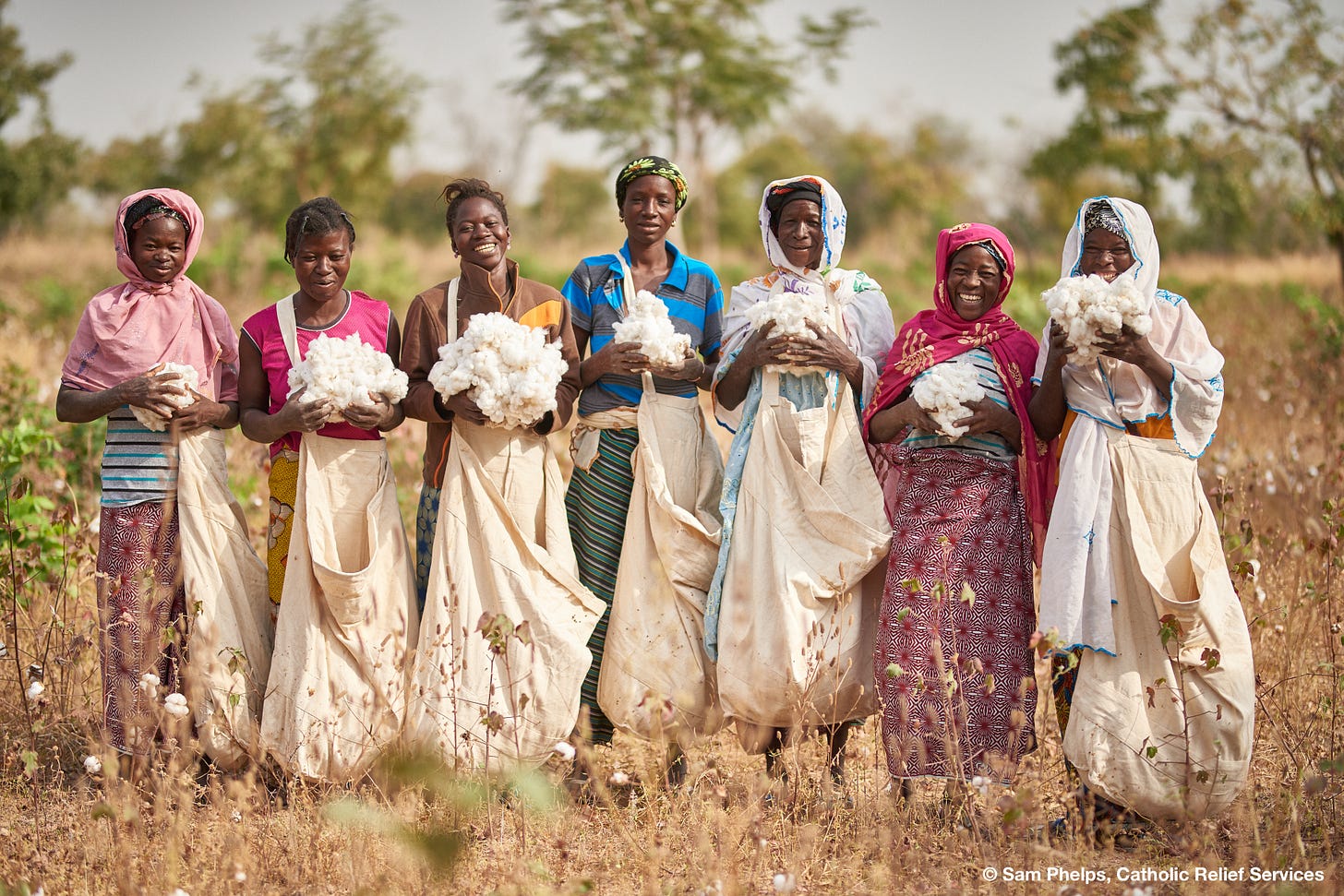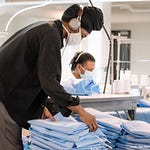Today we probe our apparel supply chains and emerge with two viable reasons for optimism. The first is a resurgence of the values that shaped the initial organic movement. The second is a model for an alternative ownership structure that places domestic production on firmer footing. Bená covers a lot of ground in this conversation, filling us in on recent turbulence in the global cotton supply and troubling indicators of a changing climate.
CHRISTIAN: Bená, you were a pioneer in what we now call sustainable fashion, and with your brand Maggie’s Organics you’ve established a precedent for worker ownership and partnering directly with small-scale farmers. But if we go back to the late ‘70s, you were marketing organic food. How did you make the transition to apparel?
BENÁ: The unlikely story, yes (laughs). So the company I was working with at the time was one of the first to market blue corn tortilla chips, and we had a farmer in Texas growing our blue corn. When the first part of the harvest came out, we had these rich, deep blue chips, but as we were pulling from later parts of the harvest, the chips were lighter–almost gray. I asked if he could do anything to fix this, and he decided to try adding cotton into his crop rotation; part of sustainable agriculture involves rotating crops, and he had some theory about fixing certain nutrients in the field if he grew cotton the season before the corn. So he planted 200 acres of cotton that year.
I was used to him being this renegade farmer who would try different things. The industry was very small back then, and the relationship you had with your farmers meant you usually sold what they grew, or at least you tried to. He called me in the spring and said my cotton’s growing, and I said great. Then he called me a couple months later and said, you know I’m going to yield a crop from this cotton. I said okay, good for you, and he said well, you need to sell it for me. I was like Jim, I sell food, it’s not food, I don’t know what you’re talking about… who cares about organic cotton? And he was like but Bena, it’s organic! So I started researching cotton with a business partner, and we found out how absolutely devastating it is for the environment–five of the top nine pesticides classified as the dirtiest pesticides by the EPA are used on cotton. They’re sprayed from crop dusters and drift and go into farmworkers, etc.
I was from the generation of blue jeans, so we just wore jeans and t-shirts all the time; our entire wardrobe was cotton. Mind you, once I found out how complicated the supply chain in clothing production is–which you know so well–I was overwhelmed and completely underwater. We invested a quarter of a million dollars in this crop and had no clue what we were going to make out of it, nor how to convert it from this beautiful stuff in the field to a finished product.
CHRISTIAN: I want to stop you there for a second and go back to crop rotation, which I thought was interesting. What other methods have you seen organic farmers use?
BENÁ: Well back in the day, we bought all our cotton from US farmers. We tried to convince every farmer we knew to put cotton into their crop rotation after our experience in Texas, and they generally rotated with a legume. Then they either grew straw or clover or let the fields fallow, so it was typically a three-year rotation here in the US. I’ve worked on four different continents now with agricultural commodity growers and cotton farmers, and most of them use a very similar rotation. As the industry has grown, rotation has become, certainly in the food industry, almost an antiquated philosophy of how to grow organically, and I think that’s what’s causing this rebirth of small-scale and regenerative agriculture.
Small-scale farmers outside of North America have much smaller farms than we’re used to and you always notice the shade trees they keep in their fields so farmworkers can get out of the boiling sun. Intercropping is also happening all over the place in Africa now. We’re working in Tanzania and they’re using it there, but the first time I came across it being used with cotton, I was working with farmers in Burkina Faso. Weevils–they’re this mealy, wormy-looking thing–are very prevalent in cotton fields, but they love okra. Okra produces a pod earlier than the cotton, so the weevils would go into the okra plants and just eat until their hearts’ content. They left the cotton plants alone until they got to the bolling stage–and by that point the cotton plants were less vulnerable.
CHRISTIAN: You mentioned regenerative agriculture, which I’m hearing more and more about. Can you talk about where that’s coming from?
BENÁ: So as the organic food movement kept growing, farm sizes invariably got larger, and this is what has kept small-scale farmers so down in many parts of the world. When you think of commodity farming in the US, you think of the Plains and fields and fields of monoculture, right? Many times that’s one farmer buying more land and learning how to efficiently grow on mega-acreage. In other countries, often farmers become part of groups and these groups negotiate brokered prices for commodities, so the farmers are still kind of forced into the situation where they’re growing the same crop in a field over and over and over. With organic standards, in my opinion, getting more lax and allowing more approved substances in the form of fertilizers and pesticides, organic has become more about acreage and less about individual farmers and crop rotation. I didn’t even know this happened, it kind of snuck up on me, because our farmers have always rotated. But I was at organic events five or six years ago and people were talking about rotating, and I was like, well our rotation is this and that–and other commodity brokers were saying, oh your farmers still rotate their crops? Like it was old-fashioned, like it wasn’t part of systemic organic agriculture.
As the whole movement got so large, and as national organic rules became prevalent in so many countries, in response there has been interest in getting back to what organics really was at the beginning–to really treating our soil with respect and working with nature. Carbon sequestration is of course part of that, and I think that’s where the whole regenerative movement is coming from.
CHRISTIAN: The organic food movement started as an attempt to rethink our agricultural system but has to an extent morphed into simply checking the boxes for certifications.
BENÁ: Right. And akin to the fair trade movement, it hasn’t been as much about small-scale producers. When larger corporations purchase products made with commodities, then of course there’s pressure to grow more, faster, faster, more. It’s just like what has happened in the fashion industry at the production level. So as a direct response to that, organic wasn’t organic anymore, and regenerative farming is, in a sense, a return to true organic farming.
CHRISTIAN: If you compare sustainable fashion to organic food and look at H&M slapping a Conscious Collection label on a mass-produced product, it’s clear that as you start to reach those volumes, the definition of sustainability gets watered down.
BENÁ: I think it’s interesting… I mean I’ve been referred to as a purist through my career on organic and fair trade (laughs) and I think that when you look back maybe 15 years ago to when Nike started first getting into organic cotton, they were into this blending program where first 1% and then 1.5% and then 2% of their cotton was going to be organic. We all kind of pooh-poohed that, and in fact when we were first writing the legislation that became the National Organic Rule–and it’s still in the GOTS standard–it said you can’t have an organic and commercial component in the same finished product. If you can source it organically, then you must source every part of a product organically. That was designed to sort of decry these larger companies blending X% of cotton into their products. These days people do what you’re just talking about; they develop these larger collections that are all organic and suddenly there’s this super big price pressure to get volume up to the levels they need in order to supply them. That’s when we question well, what does that do at the farm gate to pressure farmers into growing more and more and more? What does that lead to? And that’s when you think about the watering down of standards.
CHRISTIAN: I’d love to talk about a recent event in India that is tied to news coming out of China about organic cotton production.
BENÁ: I don’t know how many people understand the process of getting garments certified to organic, but there are independent certifying groups–some for-profit, some nonprofit–that are sanctioned by governments. The USDA has a list of probably 50 to 75 certifying agents that you can use to get your garment or your raw material certified under the USDA umbrella under the National Organic Program.
So India. I just started working there five years ago, and one of the reasons I didn’t work there sooner was because it always seemed too easy to get organic product out of India. They’re the largest or second-largest producer of organic textiles, and there were so many organic dye houses, finishing houses, cut and sew houses, brokers who had organic product… It was kind of suspect. For the first few years I worked there, I couldn’t get to the farmers I was buying from, which for us was a brand new thing–we always started from the ground up. I would say to whoever I was working with there, a dye house or knitter or whatever, well I need to know who the farmers are. And they would send to me an address and say these are the farmers, but it would be a buying office in the middle of Calcutta or another city. When I finally broke into the system and got directly to the farmers, I would hear these anecdotal stories about potential fraud.
Well, there’s this lot-tracking system where you have to have a transaction certificate for every lot of cotton. It has to go all the way back to the farm and through to the finished product so that you can, in theory, trace your product. As more large players got involved, I heard more anecdotal stories about certifiers being bought off or transaction certificates not matching the amount of cotton grown. And what happened in December was that 50% of the organic cotton coming out of India was decertified. It’s just one of those situations where you hear rumors, rumors, rumors and then poof! Half of the organic cotton in India is no longer organic.
As you mentioned, this happened at the same time that the Uighur detention camps in China started getting all the publicity. The forced labor there has been going on for a while and ironically, most of the organic cotton grown in China was coming from this region. The EU and the US decided to forbid people from bringing in commodities made in that state in China at the same time as all this cotton got decertified in India. So it’s been a total upheaval.
CHRISTIAN: That’s huge.
BENÁ: It’s huge. Huge.
CHRISTIAN: What are some of the implications in terms of pricing and supply?
BENÁ: We buy directly from farmer groups and we pre-pay for our crop–very few people do that. We had just paid our farmers in India right before all this happened, so our source of supply was secure. But as soon as everything got decertified, all these larger companies started coming to our source of supply and the price is being driven up. Even though we have a contract for a certain amount of money, we’re going to be paying more when the harvest comes in, because we know the farmers could get more if they didn’t sell to us.
So in reality, this is only helping the remaining farmers who are truly organic. Their prices depend on supply and demand, and demand is only going up. Overall, I think it’s really good for the industry, because you try to put together the most ethical supply chain you can and when there’s an area of the world where there are these rumblings of fraud, you’re just kind of waiting for a shoe to drop.
CHRISTIAN: If we look at how price is a concern for brands when they’re building organic supply chains, it’ll be interesting to see how that shakes out. You want farmers to be able to get better prices for their crops, but as supply gets squeezed, how many brands that were interested in or committed to organic cotton stay are going to stay that way?
BENÁ: It will be interesting. Coming out of the pandemic there’s so much talk about what will happen with this sustainable movement. So far, our sales are only going up, and larger players are talking with us about programs and wanting to get involved in sustainability. That’s talk in the industry–is it really going to happen when these supply demands keep getting higher and the end result is a product that costs more? I don’t know.
CHRISTIAN: If you look at how fractured supply chains were at the start of the pandemic, and at the relationships between brands and factories that were already fraught but with the cancellation and delay of orders are even more filled with tension, I thought there might be a moment for more transparency. But instead I’ve heard accounts of brands going back to factories that they already were taking advantage of or putting harsh terms on and saying we know how desperate you are and we’re going to ask you do this this cheaper, we’re going to give you net 120 terms instead of net 90.
You’ve always had a strong relationship with your supply chain, and one of the reasons is that you’ve supported alternative ownership structures. Could you tell us about that?
BENÁ: Like most things in my career, I think I first got exposed to worker ownership by accident. I was so focused on agricultural commodities when I started Maggie’s Organics that I truly was ignorant about workers in the mid-chain supply chain. I had started selling a lot of t-shirts–America’s great disposable commodity–because every two t-shirts I sold meant another pound of cotton that converted from chemical agriculture to organic. Well, we were producing our own yarn and fabric and dyes, because there were no organic standards and we wanted things to be done as cleanly as possible. Then I would take our fabric to these t-shirt houses in the South that were built for 1,200-2,000 people, but were working at 30-40% capacity because so much of the apparel industry was already moving offshore. So I’d come to this factory and say here, I’ve got all your raw materials, this is the simplest garment to sew, your factory was designed to sew these at scale, how soon can I get this order? I would get a quote of say three weeks and four weeks or six weeks later, I still wouldn’t have the order. And then the craftsmanship was just terrible. I’d get these calls from the end user saying I’ve got shoulder seams that aren’t sewn right or whatever. I couldn’t figure out how this was possible–I was working with contractors that had too much capacity, and I was making a very basic garment, yet I couldn’t get an order on time.
So I just started spending more time in the facilities. This was all in the US, and that’s when I really learned firsthand who produces clothing. 90% of the people in the facilities were women and they were undereducated or completely uneducated. Often they were single heads of households. And they got paid by the piece. If they were a hemmer, they only paid attention to their hems, because if they did a hundred hems a day, they would get minimum wage. And for every hem beyond the hundred, they would get an extra two cents or five cents or 15 cents. So they weren’t invested in the whole product they were making. That’s when I started saying to myself, wait a minute, I’m trying to convert acres and sustain life, and I can’t sustain the lives of these women. I mean, they’re breaking their backs to make barely minimum wage, and they can’t feed their children. So that’s when I said, we’ve got to change the model–the model’s broken.
At this point we ran into an NGO in Nicaragua that was dealing with victims of Hurricane Mitch. They were trying to find employment for people rather than charity. We asked do any of these women know how to sew? They said sure, there’s a sweatshop industry in Nicaragua, why? And we said well, we need to build a facility where every worker has a vested interest in our success, how can we do that? And they said to me, what about a worker-owned cooperative?
The only co-ops I knew were food co-ops, but I said, oh yeah, let’s try that model, that sounds really like it could work.
CHRISTIAN: Did it work?
BENÁ: So that co-op worked for a while like a dream. The women built it from the ground up, literally built the building themselves. We put in a t-shirt line, a basics line, and then we put in a line to do camisoles and just a little more upscale knit garment so that we could use the t-shirt line as a training line, and then when people wanted to make more money and were feeling more secure in their ability to sew, we’d transfer them. It worked for probably three or four years and then it completely crashed and burned. I’ve asked myself so many times you know, what really happened, what was the real root of that? And my only answer is that we were working in Managua, in Nueva Vida specifically. Nicaragua is the second poorest country in the hemisphere next to Haiti. Nueva Vida means “new life” in Spanish and is basically a relocation village for victims of the natural disasters that happen in Nicaragua all the time. The women were truly worker-owners. They truly had a democratic system; every worker had a vote on every decision they made. But I think in their hearts they just thought they were going to fail. I used to tell them, for every step forward you take two steps back. Every time I tell you this is a great order, the next order comes in and it’s terrible. It was almost a psychological thing where I truly believe they sabotaged themselves. I still believe in the model. Man they were capable of sewing things they had no business sewing and doing a damn good job at it. And it was because, I feel, they were vested in their own business, and they knew that this was a way to feed their families.
We started our next co-op in North Carolina. We were involved with an NGO that was really hands-on, kind of running the place. And that project, Opportunity Threads, worked very, very well.
Our dream in Nicaragua had been to build a vertical supply chain that was all worker-owned, and I still believe that that is possible, I guess I just didn’t have the wherewithal to do it myself. Talking about slow money and slow investing, I sacrificed a lot of growth in the company to stay loyal to my mission there, which was: I won’t develop any products if you can’t sew them… I’m only going to develop what you can sew.
CHRISTIAN: It was the first worker-owned company that ended up in an area designated as a free trade zone, right?
BENÁ: As far as I know they’re still the only worker-owned free trade zone (well, they’re not in business right now) in the world in any industry. And it was wonderful, the women became so capable. They had had to import all their own thread, because they couldn’t buy from the free trade zone thread offices, and then they couldn’t buy boxes or labels at the places that all the free trade zones could. The women went to the free trade zone office and said we want to become a free trade zone. They kind of got laughed out of the office.
But then they went to the Nicaraguan government and said how do we do this? The Sandinistas were still in power, I think, or had just gotten back into power, and the Sandinistas are more in line with cooperatives.
They had to set up an organization above their cooperative in order to get the status they needed to become the free trade zone, and it took a few years. We helped raise a couple hundred thousand dollars for them, but they did it. And once they were a free trade zone, life was so much easier. That’s when I thought they were really going to take off, but by that time there were all these internal issues happening within the company, sabotage and jealousy.
CHRISTIAN: Free trade zones don’t necessarily have a great name, so it’s interesting to hear them applied in a way that isn’t detrimental to a local economy.
BENÁ: Right!
CHRISTIAN: What other policies have you seen facilitate more sustainable business practices?
BENÁ: Well, I wouldn’t say policies as much as things like the Global Organic Textile Standard. When we first wrote that, we were a splinter group of the Organic Trade Association. People were beginning to market organic clothing who didn’t have a clue what was really involved; they thought if they just bought organic cotton, they wouldn’t have to control the whole production cycle. We started saying well, that’s not really enough, if you’re going to call something organic then you need to make sure the dyestuffs don’t cause cancer, the effluent water is maintained, etc. So we started writing the standard with the help of the Organic Trade Association, and we used the fledgling organic food standards at the time as our model. We actually came up with categories of finished product based on the percentage of organic materials in each product that mimicked food and then those became part of the Organic Trade Association’s doctrine.
As you recall, the first National Organic Rule came out and allowed sewage sludge and irradiated food and a whole bunch of other things. It actually got more comments than any other law at its time in history, so the federal government pulled that law and started over. The second time the National Organic Rule was going to become law, we thought our efforts to set standards for every stage of production of organic textiles would become part of that law. But then in their inimitable way, the USDA decided to only mention clothing in the preamble of the rule and only suggested that people should follow this voluntary set of standards.
So to me that’s an example of rules and regulations not working to our favor, though I will say that even that sanction by the government gave us the ability to say to new supply chain partners, here’s the blueprint you need to follow. Certainly legislative efforts could help so much, not only in organic, but in treating people with respect and dignity and ensuring that supply chains are truly sustainable. But I don’t have a lot of success stories relative to that.
CHRISTIAN: I am hoping that Senate Bill 62 which we touched on in a previous interview with Ayesha Barenblat becomes a success story and establishes a minimum wage for garment workers in LA.
BENÁ: Even just to get standards for hourly wages versus piecework or a minimum monthly would be a start. If we could just get everyone that’s producing apparel in this country to live by trade laws it would be a huge start.
CHRISTIAN: I know you continue to do some manufacturing in the US, but it certainly isn’t the core of your production at this point, right?
BENA: It actually still is more than 50% of our production–but it is only socks. Well, that’s just because of volume. More than 50% of our dollar production happens in the US, made from imported materials because of our relationships with farmers. We could still switch our socks to being offshore and probably save 25-30% of the cost of production, but it’s part of our ethos now. We’ve been through seeing so many mill close, and it’s been the survival of the fittest. We’re working with sock manufacturers who are third and fourth generation.; they’ve hung on, and they’re now very secure and our contracts with them are very secure. We won’t ever, I think, move offshore with our socks. Unfortunately with apparel it’s not so much about cutting and sewing, because even when we started the co-op in North Carolina we could get our products sewn in the US–but to get our entire supply chain in the US, even yarn forward, would just be a very big challenge.
CHRISTIAN: You’ve seen the whole industry decimated. Spinning, dye houses... there are just missing chunks. Is that what it is?
BENÁ: I think a lot of it is that. I think we’re losing expertise, especially at those mid-supply chain levels. Though we do work with two dyers, both in North Carolina–one is an immigrant company and the other is an old school dye house that’s been around, Meridian–it’s kind of come out of the ashes and held on. Using Meridian as an example, they dye I think all of our wool now and maybe not our cotton? And tubing is a very important part of dyeing. It’s a skillset that very few people still have. We had socks this past fall that we were having all sorts of quality control issues with, we were getting orders late etc, and finally we got to the root of the problem at Meridian. They said oh, the tubers are getting national unemployment checks, so we lost all our tubers. And I’m like you guys, this is an international pandemic and you let your tubers leave? I mean, go find them! It’s a dying art form.
I think yes, you’re hitting the nail on the head that there’s a lack of skill because the industry has been gone for so long, and I think maybe companies aren’t willing to do what it takes to bring the skillsets back?
CHRISTIAN: You and I have talked about this because you’re a former board member at ISAIC, and we’re tackling one small piece of it there. If you look at every operating level, spinning, knitting, linking–maybe basic cutting and sewing you can pick up relatively quickly, but production quality at an efficient pace across the whole supply chain is not easy.
I think it’s interesting that you’re doing socks here, because socks is a much more automated category relative to some of the other pieces that you make. With the investment firm I’m working on, socks is towards the top of our list because of that. There are numerous facilities doing $15-20 million a year in production and a bunch of smaller ones, which is not necessarily the case in many other categories in the industry.
BENÁ: But you’ve also been involved recently in potential joint ventures where maybe the technology from another country is going to come here, yes?
CHRISTIAN: Yeah. I think even if you look at how Shinola was set up in Detroit, they were bringing in masters and foreign partners who had those skillsets. As we look at these categories, that’s the path forward, because to try to build from scratch–we tried that at Lazlo and when you have as little experience as I did and try to start in a category, it’s very difficult.
BENÁ: Yeah. So maybe the pandemic is a great equalizer for that too–certainly people are more creative and entrepreneurial right now.
CHRISTIAN: I really do think domestic manufacturing has a role to play in the overall supply chain. It feels like there are products in a bunch of different categories that from a speed perspective and from a cost of raw material perspective are reasonable to do here.
BENÁ: I agree.
CHRISTIAN: Changing gears, can you talk about how your supply chain has been impacted by climate change?
BENÁ: Sure. We began by contracting with all US farmers–our intent was never to go offshore with our contracts for cotton. We thought, why not stay in North America? Then biofuels took off and our farmers were simply not planting cotton anymore, because they could make more money growing corn. A couple of them reneged on contracts we had, which was challenging since we were a small company without a backup source of supply. Meanwhile, the NGO we were working with in Nicaragua on the co-op also exported food commodities, so I asked whether any of the farmers there were interested in growing cotton.
Well, cotton had been Nicaragua’s largest export commodity before the Sandinista revolution, but they had been sold a bill of goods by hybridized cotton and had ruined so much of their soil by spraying it to heck with all these pesticides that they couldn’t even grow cotton anymore. So we worked with an agricultural university in Managua to develop a strain of cotton that was specific to the Nicaraguan climate. We got a few farmers here and there to say ok, we’ll do cotton this year. And then we got enough of them that we actually harvested a crop.
I couldn’t get the cotton spun in North or Central America without having it fumigated upon leaving the country and being imported into the other countries–this is a fight we’ve had with the FDA for a long time. I’d pledged to these farmers if you grow good organic cotton, I’ll buy it from you, and here it’s sitting in their barns getting ruined. They’re like, you said you were going to use this stuff. So we went through years of that! Finally a spinning company in El Salvador was able to import it, and they started spinning it for us.
About the time we started getting really good yields and figuring this is going to be the thing we can hang our hat on, we can build a company around this cotton all from Nicaragua, climate change showed up.
Very few farmers outside of the US irrigate their crops, they’re too poor. There are two seasons, the rainy season and the dry season, and you plant and harvest around the rains. Well, the rains stopped coming. They’re supposed to come in April, they’re supposed to come in May, they started coming in June–and by then it was too late to plant. By the time they planted, the plants were stunted and their yields would be very low. I think we had a three-year contract, and the first year they lost 20% of the crop, the second year they lost 40%, and the third year the crop was virtually decimated. So once again, here we are with all these orders for finished goods and we can’t even get our cotton off the ground.
Then I went to Peru. This is back in 2005–we were already working there a little bit. I said to the Peruvian farmers ok, climate change is happening, how are you going to mitigate this? And they said oh, we get water from the Andes. There are farming communities around the river beds. They’re like, we’re not going to ever have a problem, don’t worry. The next year, they had a huge problem. I mean I have pictures of the same field from year to year and the first year the plants are like four feet tall, and the next year they’re like four inches tall.
We started a campaign to educate our customers and said we’re going to donate X cents from every garment you buy to get these farmers potable water. By the time we raised the funds to dig wells, they were literally underwater; they had had floods from the Andes. And we lost that crop.
So here I have this relatively small company, and I’m feeling like I have to contract from at least two different continents just to get a crop I can work with. Still to this day, small-scale farmers feed the world. I think the last statistic I read is something like 60% of what we eat is grown by small-scale farmers. Those guys are on the frontlines of climate change. If you don’t have money for a sophisticated irrigation system, you live by nature. If nature brings you water, then you eat. And if nature doesn’t bring you water, you don’t eat. It’s what inspires me to keep going, because if we continue the way we’re doing farming in this world, we’re all going to perish–the handwriting’s on the wall. Finally, climate change is starting to hit developed countries so maybe now something will change.
CHRISTIAN: What do you think that change might look like?
BENÁ: That’s a really interesting question. I think communities work best if they’re limited in scope. The whole idea of self-sufficiency, I think that that would be an answer to the climate crisis. If we could develop communities near us and try to be self-sufficient. In Michigan, farmers are using hoop houses with the goal of being able to feed everyone in the state year-round. Now that it’s 8 degrees below zero today, that’s a tall order, but I’ve seen farmers pull off miracles. We have the ability to do this, we just have to really look at things differently I guess.
CHRISTIAN: It just feels like there are very few things that scale without losing their soul–which maybe sounds super woo-woo. But if you look at say political change, you can have leaders who inspire people but to really drive change you need engagement in local communities. You don’t start at the presidency to drive real change. And it feels like with climate change, we can talk about international policies, those are important, but we also need to understand how our communities can independently take action.
BENÁ: You know, our company’s in a growth mode right now, and we’re hearing from large corporate players who want us to scale. As we get into the greater fashion world, people are saying your product’s too affordable, you price your products too low. I’m always getting pressure from our sales people to raise our prices. I ask them, what is it really going to do for us? Our MO is to make clothing affordable, we want people who choose to maybe not make millions in their career–choose!–to still be able to afford a good pair of socks or leggings or whatever. If I just keep raising prices so that I can afford to implement these programs from all these corporate players, then my neighbor can’t afford my clothes, and really what have we accomplished? It puts me under more pressure, it puts us under financial stress to raise more. I guess I’ve chosen to not grow our company as much as people expected.
CHRISTIAN: As you know, I ended up on the opposite end of the price spectrum, and I was thinking the other day about the metric for return on impact. Your return could be in social impact, it could be environmental, quality of life–but it felt like higher-priced goods support better jobs and more families with a smaller environmental impact if done right. At the same time we’re in a situation where, due to the inequality we have in this country and the stagnation of wages for large swaths of the population, affordability is a real question around clothing. I think I’ve struggled to balance higher prices that support everyone in the supply chain, and the desire for everyone to have the choice of organic. You just touched on that, and in terms of the levers you can pull around people being able to afford organic, it’s the price of the end good, but it’s also the wages that people are making.
BENÁ: And then it’s also how you bring the product to market. I think that’s what I was trying to eliminate post-Covid. We’re trying to find efficiencies in our supply chain so we can bring product to market more affordably. Because of our price philosophy and retail price, we do put price pressure on our supply chain, but I like to think we do it in a more responsible way than some of the corporate players. I find that the closer we get to our supply chain partners, they understand oh, I see, you’re not just taking this as profit for yourselves, you’re passing it on to the market–and therefore the volume will naturally go up. Which I know is a very different philosophy than the luxury market. But it’s a constant challenge, it’s a constant challenge.
CHRISTIAN: Yeah, the answer is probably a mix of all of the above. If we don’t find a way to bring the price down for a large percentage of the goods that are produced sustainably, it’s going to be very difficult for them to be widely adopted.
BENÁ: And we need to bring the value of goods up as well. Now that the discount-driven market is so prevalent, with designers designing for these discount retailers… you just think of the landfills. It’s this cycle of downwards pressure that’s just not making any sense. We need to work with partners and supply chains to try to find efficiencies, and then we also need to put pressure on consumer culture–like you did at Lazlo I think–to shape the perceived value of the product.
This conversation has been lightly edited for clarity and length.












